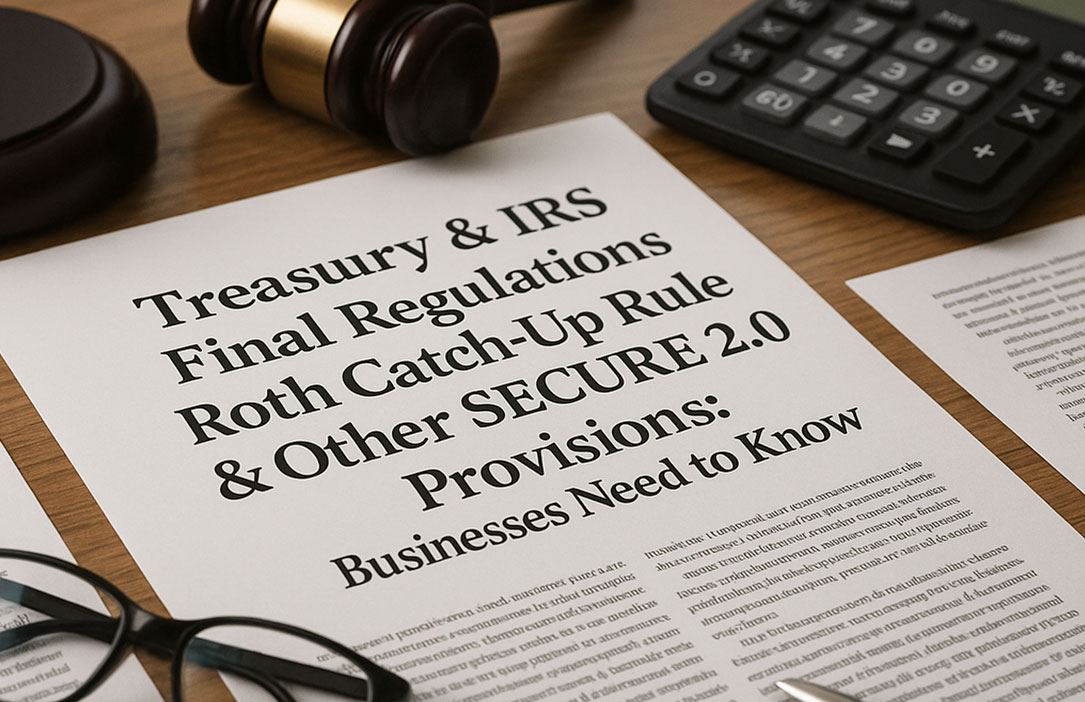
What Is the SECURE 2.0 Act & What’s Changing
The SECURE 2.0 Act of 2022 has made several adjustments aimed at enabling Americans to save more towards retirement and update the rules to regulate the retirement plans. One of its provisions is that under some conditions, some of its catch-up contributions must be referred to as Roth (after-tax) contributions. Recent final regulations under the Treasury and IRS explain how this requirement operates, who is affected, and at what point.
Catch-up contributions are additional contributions that individuals aged 50 years and above may make in 401(k)s and 403(b)s, 457(b) governmental plans, and similar retirement plans. The reforms are expected to make the system fairer, more efficient (to raise revenues), and more effective (to streamline the administration) by ensuring that higher-income catch-ups pay up sooner instead of later.
Key Provisions of the Final Regulations
Here are the most important parts of the final regulations under SECURE 2.0 and what employers & plan admins need to understand:
| Provision | What It Does | Who It Affects |
| Roth Catch-Up Requirement |
Participants who are 50+ with FICA wages above a threshold must make their catch-up contributions as Roth (post-tax) contributions. |
Higher‐income workers in retirement plans are covered by the regulation. |
| Wage Threshold |
The threshold will be 145,000 in FICA wages in the preceding year, which will be increased by the cost of living. |
Plan sponsors and participants need to monitor all participants to find out whether they are exceeding the threshold. |
| Raised Catch-Up Limit Ages 60-63 Super catch-up limits raised |
Individuals between the ages of 60 and 63 can make higher catch-up contributions than those who are only 50 years old. These enhanced limits are scaled (150%) of the base catch-up limit for those plan types. |
Workers of eligible plans who are between 60 and 63 years old; the limit should be permitted in the plan documents. |
| Simple Plans Exception / Special Rules |
For certain SIMPLE plans and other smaller or special plan types, different catch-up limits or transitional rules apply. Some plans are given flexibility. |
Employers sponsoring SIMPLE retirement plans and plan administrators. |
| Effective / Applicability Date |
The Roth catch-up requirement applies in general to taxable years commencing after Dec. 31, 2026. It has a transition period; the reasonable, good-faith implementation can be made earlier. |
Plan administrators need lead time to amend plan documents and operations. |
Changes From Proposed Rules
Several changes were made in response to public comments. Some of the noteworthy adjustments:
- Plan administrators may aggregate wages from separate common‐law employers (or entities) to determine whether a participant meets the Roth catch-up wage threshold.
- Clarifications on how to correct failures if a catch-up contribution was made pretax when, under the law, it should have been Roth.
- Rules for “deemed Roth election” and requirements for plan documentation & procedure.
- Special rules for plans covering participants in Puerto Rico.
When Do These New Rules Take Effect?
- Most of the regulations have their applicability to taxable years after December 31st, 2026.
- There’s a transition period through the end of 2025 (under Notice 2023-62) during which a plan can apply a good-faith interpretation of the upcoming rules.
- Some types of plans are later dated, like those of governmental or under a collective bargaining agreement.
Why This Matters: Implications for Employers, Plan Sponsors & Employees
These are not just technical changes but actual changes. The following are what various stakeholders should look out for:
- Plan Administrators and Employers: This will be required to revise the plan documents, payroll systems, and communication materials according to the Roth catch-up requirement and the higher catch-up limits.
- Payroll Teams: Payroll Teams need to be precise in tracking the wages, particularly FICA wages, to ascertain who to cross the threshold. Rules of aggregation can be helpful, but also complicate the process.
- Employees / Participants: Participants ought to know the tax implications of pre-tax and Roth catch-up contributions to their current tax status as compared to their future tax status in retirement. Some may prefer Roth for tax-free future withdrawals, but Roth contributions increase taxable income now.
- Compliance and Corrections: There are possibilities of errors and, hence, the final rules involve correction routes (W-2 corrections or in-plan rollovers) in case the catch-up contributions were assigned incorrectly. Plan sponsors should have systems in place to detect and correct errors.
What Employers Should Do Now: Checklist for Implementation
To get ready, here’s a practical checklist:
- Review Plan Documents & Amend Them to allow for required Roth catch-ups and increased limits.
- Revamp Payroll Systems and Records to track the wages, implement the new thresholds, and provide the right contribution options.
- Communicate With Participants, telling them what is changing, especially where they are approaching or over the wage threshold, or they are 60-63 with higher limits.
- Train Benefits / HR Educate about compliance, wage aggregation, correction techniques, and the so-called Roth election.
- Use Good Faith Practices when it is implemented before 2027; make sure that the procedures are documented so that the plan can demonstrate compliance.
Conclusion
The last IRS regulations under the SECURE 2.0 are a clarification that formalizes significant modifications, which will impact contributions to retirement plans, particularly among older and more wealthy individuals. It is time that employers, payroll administrators, and benefits professionals start preparing. The updating of documentation, systems, payroll workflows, and communications will be very important in ensuring that compliance is realized before the 2026 applicability date.
It is high time to re-examine what you are doing today, see where adjustments must be made, and be sure that your plans comply with the new provisions of the Roth catch-up rule and any of the associated revisions of SECURE 2.0, should you handle retirement plans or advise businesses.
